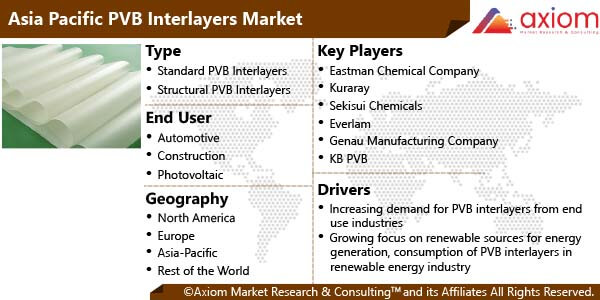A polyvinyl butyral (PVB) interlayer is the most commonly and widely used glass interlayer or laminated glass. It is a clear interlayer, available in a variety of thicknesses, that can be used to increase the security, strength, or safety of a glass construction. Laminated glass have numerous benefits such as improved safety, security, noise insulation, solar energy control, improved protection, and many others. Owing to its shatterproof quality and strength, laminated glass finds wide range of applications in areas both commercial and residential construction applications.
Market Dynamic- Asia Pacific PVB Interlayers Market
The Asia Pacific PVB interlayers market is growing at a rapid pace. Asia-Pacific automotive market in especially in countries like China, India, and Japan is one of the largest revenue generation sector in the APAC region. Rapidly increasing number of manufacturers providing advanced technology based vehicles and other automotive components are important factors supporting the high-paced growth. Moreover, PVB interlayers are widely used to cover the window panels as a protecting layer. Furthermore, these interlayers are also used in automotive vehicles to make them look attractive and for safety purpose. These factors are anticipated to propel the growth of PVB interlayers market in the Asia-Pacific region during the estimated timeframe.
COVID 19 Impact on Asia Pacific PVB Interlayers Market Report
The exclusive COVID 19 impact analysis report by Axiom MRC provides a 360 degree analysis of micro and macro-economic factors on the PVB interlayers market. In addition, complete analysis of changes on PVB interlayers market expenditure, economic and international policies on supply and demand side. The report also studies the impact of pandemic on Asia Pacific economies, international trade, business investments, GDP and marketing strategies of key players present in the market. COVID-19 pandemic has negatively impacted end use industries such as automotive, construction and photovoltaic industries. This is owing to the shutdown of various Asia Pacific automotive manufacturing facilities and shortage of labor force and raw materials during early pandemic period.
Asia Pacific PVB Interlayers Market Segmental Overview
The study analyses Asia Pacific PVB interlayers market based on type, end use industry and country.
PVB Interlayers Market by Type
Two major types such as standard PVB interlayers and structural PVB interlayers are analyzed in the Asia Pacific PVB interlayers market. The standard PVB interlayers segment dominated the market in 2020 and is expected to maintain its dominance during the forecast period. However, structural PVB interlayers segment is expected to witness rapid growth in the coming years. Increasing demand for structural PVB interlayers owing to its benefits such as post breakage safety, superior edge stability, enhanced unit strength, enhanced interlayer strength, improved throughput and reduces costs is driving the growth of the market.
PVB Interlayers Market by End Use Industry
Major end use industries of the Asia Pacific PVB interlayers market are automotive, construction and photovoltaic. The automotive end use industry is expected to dominate the market during the estimated period. On the other side, photovoltaic and constructions segments are likely to improve the PVB interlayers market in the coming years. PVB interlayers in automotive application provides high-performance benefits such as light transmittance, solar protection, acoustics, and security, which is making it more demandable in the automotive end use industry.
PVB Interlayers Market by Country
Country wise, the study is comprised of the key countries of such as the China, India, Japan and rest of Asia Pacific. The China likely to dominate the Asia Pacific PVB interlayers market during the estimated time frame. Major growth factors such as growing solar photovoltaic installation, rising production of electric vehicle, and increasing building and construction projects in the APAC region are accredited to the market growth. Likewise, rapidly growing automotive manufacturing industry in country’s such as China and India is boosting the market growth. For instance, according to IBEF, in 2020, India was the fifth-largest auto market, with approximately 3.49 million units combined sold in the commercial and passenger vehicles categories.
PVB Interlayers Market Key Players
The major key players of market include Eastman Chemical Company, Kuraray, Sekisui Chemicals, Everlam, Genau Manufacturing Company, KB PVB, Chang Chun Group, Dulite Co.Limited, Huakai Plastic Co., Ltd, Willing Lamiglass Materials, Jiangsu Darui Hengte Technology and Tiantai Kanglai Co., Limited among others.
Recent Developments:
March 2021: Eastman Chemical Company announced it is making an investment to expand and upgrade its extrusion capabilities for production of interlayers product lines at its Springfield, Massachusetts, manufacturing facility. The investment will strengthen the company’s supply capability to respond to global and regional demand for Saflex polyvinyl butyral (PVB) products in the architectural and automotive markets.
January 2021: Kuraray announced that it is continuing to invest in its Czech production site in Holešov. The investment will expand the manufacturing of its SentryGlas product, the film for glass interlayers made of ionoplast and will enable the plant to manufacture the class-leading interlayer on rolls widths up to 330 cm.
November 2020: Eastman Chemical announced the partnership with Seen, a Swiss architectural-surfaces specialist, to market a line of bird-safe interlayers for laminated architectural glass. The partnership fits in with the company’s current business in polyvinyl butyral (PVB) interlayers for automotive and architectural safety glass.











